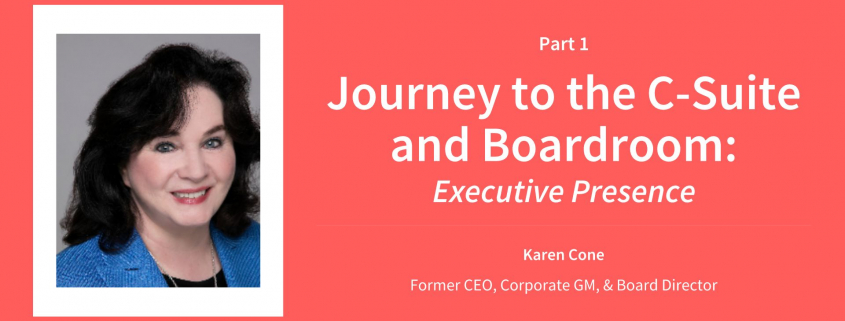My journey to the C-Suite and the boardroom has been successful. It was, however, more rocky and slower than many of my male counterparts of equal (or even lesser) competency. I learned many lessons along the way and I am sharing them with you, in hopes they will help others along their own career journey. Here is one of them.
How honest feedback changed my trajectory?
I spent the first half of my career at IBM. It was challenging in a good way and I was continuously learning and growing. I held exceptionally diverse roles from international sales to regional staff to global account marketing manager to country product manager and corporate head of software business practices. I had assignments in the US, France, Russia, Japan, and China. It wasn’t easy, as during this time I also brought three children into the world and was raising them with my husband. Nonetheless, I continued to progress and move up the ladder, until I didn’t. In hindsight, one could say I hit the glass ceiling and did not know what had happened.
I was a second-line manager and one level below “executive.” My performance ratings were top notch. All that said, I was going into my sixth year at the same level with no apparent prospects of promotion, while male colleagues with performance results less than mine were moving into the executive ranks. I worked incredibly hard and consistently delivered. I was confused. I knew I must be doing something wrong, but did not know what.
The director of my group was promoted and was replaced by a woman executive —for the purpose of this story, let’s call her Carolyn. After only six weeks, the new director decided unexpectedly to move on from IBM. As Carolyn prepared to depart, I requested a meeting. I realized that this manager who had observed me for many weeks could provide some blunt feedback with no conflicting agenda. I asked Carolyn for insights as to why my career had stalled.
Carolyn was certainly blunt. She said the issue was not my performance, it was excellent. Instead, it was the image I projected while getting the job done that was blocking my rise into the executive ranks. Apparently, as I strived to meet all deadlines in a complete manner, I came across as someone always in a rush and, thus, not in control. My focus was on what still needed to be done, rather than taking time to acknowledge and celebrate what was already accomplished. This gave my colleagues and management, mostly men, the opportunity to take credit for these accomplishments without recognizing my leading role. Most importantly, Carolyn said I was perceived as a high performing “worker bee”. I did not project the executive presence required for a senior leadership position. My direct reports recognized me as a leader, but key stakeholders impacting my career did not.
It was like a bucket of freezing cold water had been dumped on me. I was both shocked and grateful. Grateful that Carolyn had been so open with me. Shocked at the truth of what she said. And disappointed in my lack of self-awareness. I felt the need to try harder, as women often do. Nevertheless, it was clear that my glass ceiling was as much of my own making as it was due to a male-dominated work environment. It was time to reinvent myself and my image.
Lessons learned in executive presence
That said, the perception of others creates a reality that is difficult, though not impossible, to change. The very next morning, I stopped rushing. I immediately realized that I needed to walk into meetings calmly with my head high, not looking down at my papers or what today would be my laptop or smartphone. I needed to come across as confident and in control. Gathering my courage, I began to change some of my behaviors, including:
- Discussing what was done and not apologizing for what was not done
- Speaking up in meetings without asking permission first
- Replacing “I hope this meets your needs” with “I am confident this will meet your needs”
- Avoiding phrases like: “try to, hope, feel, perhaps you could…”
- Finding opportunities to share soundbites on successes, without being boastful
- Gaining support of key stakeholders in advance of meetings
There is one critical behavior that I practiced then and continue to this day — ensuring that the successes of the team, as well as the individuals on the team and our collaborators, are recognized and promoted. I firmly believe this is an essential part of leadership excellence. It drives achievement and benefits the organization as a whole.
So how did I fare with my “re-invention”? It made a difference. My voice carried more clout and the outcomes were impactful. That said, I realized that changing the perception many stakeholders held of me would take considerable time with an uncertain outcome. I concluded that this was an unacceptable risk and that my time was better served elsewhere, so I successfully moved my “re-invented self” to a new opportunity.
At times one is so consumed by the need to succeed that we ignore the successes we have achieved. I hope my story helps you understand the need to step back and look at everything you have accomplished and course correct to accomplish more. Stay tuned for more!
Karen Cone FORMER CEO, CORPORATE GM, & BOARD DIRECTOR
Karen Cone is the former Microsoft General Manager, Worldwide Financial Services Sector, and CEO and Board Director of the advisory research firm, TowerGroup. She currently serves on multiple advisory boards and is a venture partner for the MastersFund, focused on women founders in technology. Karen has also held senior executive positions with increasing responsibility and scope at IBM, MasterCard and Gartner, where she served on the Gartner International Board. She has lived and worked in the Americas, Europe & Asia. Karen and her husband, Jeff, have three sons and four grandchildren and currently live in Seattle, Washington.




